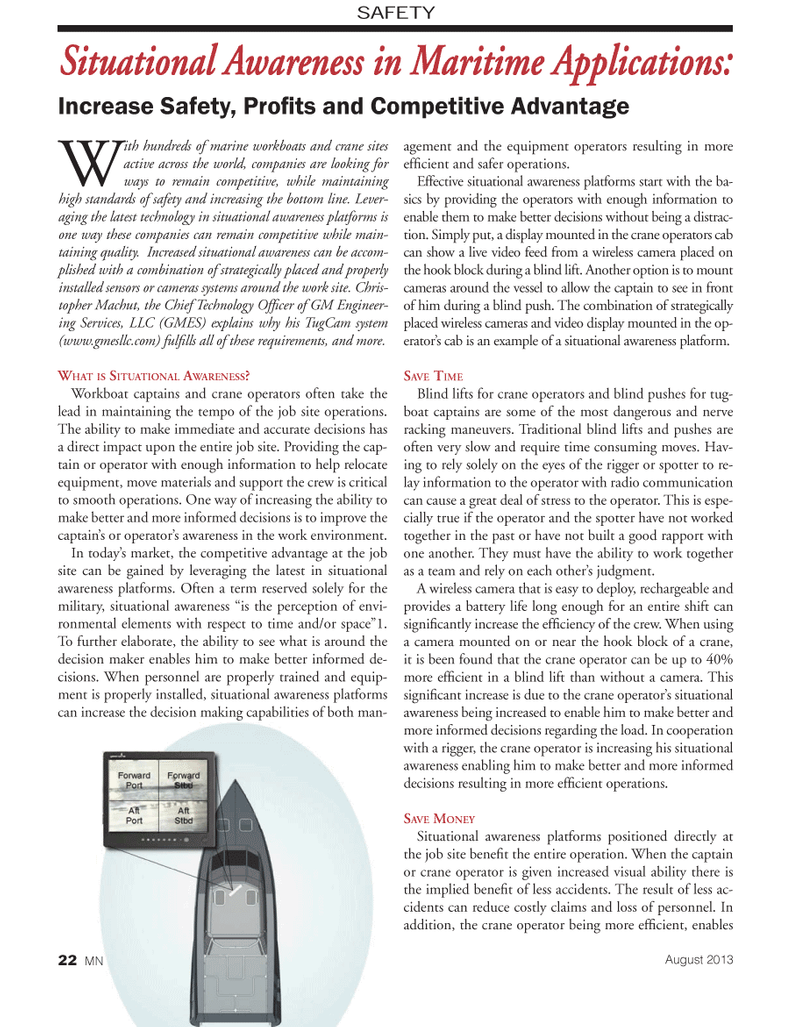
Page 22: of Marine News Magazine (August 2013)
Salvage & Response
Read this page in Pdf, Flash or Html5 edition of August 2013 Marine News Magazine
With hundreds of marine workboats and crane sites active across the world, companies are looking for ways to remain competitive, while maintaining high standards of safety and increasing the bottom line. Lever- aging the latest technology in situational awareness platforms is one way these companies can remain competitive while main- taining quality. Increased situational awareness can be accom- plished with a combination of strategically placed and properly installed sensors or cameras systems around the work site. Chris- topher Machut, the Chief Technology Of? cer of GM Engineer- ing Services, LLC (GMES) explains why his TugCam system (www.gmesllc.com) ful? lls all of these requirements, and more. WHAT IS SITUATIONAL AWARENESS ?Workboat captains and crane operators often take the lead in maintaining the tempo of the job site operations. The ability to make immediate and accurate decisions has a direct impact upon the entire job site. Providing the cap- tain or operator with enough information to help relocate equipment, move materials and support the crew is critical to smooth operations. One way of increasing the ability to make better and more informed decisions is to improve the captains or operators awareness in the work environment. In todays market, the competitive advantage at the job site can be gained by leveraging the latest in situational awareness platforms. Often a term reserved solely for the military, situational awareness is the perception of envi- ronmental elements with respect to time and/or space?1. To further elaborate, the ability to see what is around the decision maker enables him to make better informed de-cisions. When personnel are properly trained and equip- ment is properly installed, situational awareness platforms can increase the decision making capabilities of both man- agement and the equipment operators resulting in more ef? cient and safer operations. Effective situational awareness platforms start with the ba- sics by providing the operators with enough information to enable them to make better decisions without being a distrac-tion. Simply put, a display mounted in the crane operators cab can show a live video feed from a wireless camera placed on the hook block during a blind lift. Another option is to mount cameras around the vessel to allow the captain to see in front of him during a blind push. The combination of strategically placed wireless cameras and video display mounted in the op- erators cab is an example of a situational awareness platform. SAVE TIMEBlind lifts for crane operators and blind pushes for tug- boat captains are some of the most dangerous and nerve racking maneuvers. Traditional blind lifts and pushes are often very slow and require time consuming moves. Hav- ing to rely solely on the eyes of the rigger or spotter to re- lay information to the operator with radio communication can cause a great deal of stress to the operator. This is espe- cially true if the operator and the spotter have not worked together in the past or have not built a good rapport with one another. They must have the ability to work together as a team and rely on each others judgment. A wireless camera that is easy to deploy, rechargeable and provides a battery life long enough for an entire shift can signi? cantly increase the ef? ciency of the crew. When using a camera mounted on or near the hook block of a crane, it is been found that the crane operator can be up to 40% more ef? cient in a blind lift than without a camera. This signi? cant increase is due to the crane operators situational awareness being increased to enable him to make better and more informed decisions regarding the load. In cooperation with a rigger, the crane operator is increasing his situational awareness enabling him to make better and more informed decisions resulting in more ef? cient operations. SAVE MONEY Situational awareness platforms positioned directly at the job site bene? t the entire operation. When the captain or crane operator is given increased visual ability there is the implied bene? t of less accidents. The result of less ac- cidents can reduce costly claims and loss of personnel. In addition, the crane operator being more ef? cient, enables Situational Awareness in Maritime Applications: Increase Safety, Pro �À ts and Competitive Advantage gpSAFETY22 MNAugust 2013MN August2013 Layout 18-31.indd 227/23/2013 7:15:56 PM

 21
21

 23
23
